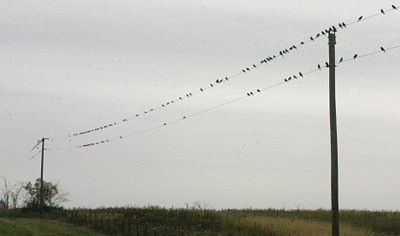|
TALES from the FRONT PORCH
Ringgold County's Oral Legend & Memories Project

We've got robin view, not eagle cam
OPINION: THOUGHT & other things
by Alan Smith

The eagle cam in Decorah that followed the eagles as they were hatched and had hundreds of thousands of visitors to a
website has nothing on the Smith back porch. Well, maybe it has eagles and a video cam that we don't have, but they don't
have robins. Valle discovered the nest first. The mother robin decided that the ledge outside the screen on the
corner of the screened in back deck would be a good place for a nest, I guess. The nest was right up to the screen, which
made it pretty safe from marauding neighborhood cats and squirrels, but gave us a perfect view of the nest, but with a
screen barrier to protect the robin's home. We noticed the robin sitting on the nest first, and when the bird flew away
we found five robin blue eggs in the nest. A clutch of five eggs is on the highend of the amount a mother usually lays in
the nest, we found after some research. Mother robin does all the incubating work. Every few days we would venture out
on the back porch and take another peek. Soon we saw some hatched baby robins in the nest. The first view of the young
chicks was little naked bodies and closed eyes in the nest. Without our webcam we didn't see how the five eggs ended
up with three hatchlings that survived. That might have been too graphic for young eyes. We only know that when we
looked again there where three hungry heads sticking up over the edge of the nest waiting for a meal. The mother robin
broods the chicks continuously while still young, then begins to come back to brood them only at night or during bad
weather. Mom and Dad robin both are active in feeding the chicks until they can learn to forage on their own. They
bring a diet of worms and other soft-bodied animal prey back to feed their young. Parents dine on beetle grubs,
caterpillars, grasshoppers, worms, fruits and berries, we found out. I wondered why there didn't seem to be any waste
accumulating in the nest and some research discovered the reason. Mom and Dad don't change diapers, but after being
fed, the chicks raise their tails and the parents collect the solid white clumps of waste and fly off
with it. I'm glad humans don't use the same technique. According to my research, it won't be too long now before the
birds will have changed again from hungry mouths of strange looking creatures to fledgling creatures that will leave
the nest. Our robins only have about a 25 percent chance of surviving the first year, I have found, but the oldest
robin on record was 14 years old. We'll hope that our back deck brood has a little better luck than the average, though
once they are gone we'll probably never know any more about them. And once out of the nest the neighborhood cats will
have more of a chance to have a meal, I'm afraid. It only takes a couple of weeks from the time they leave the nest
until they are proficient flyers, but that period where they perch in bushes or trees for protection from predators
makes them pretty vulnerable. Unfortunately we didn't have grandchildren Eli and Millie around to show off our back
deck visitors to. I'm sure they would have enjoyed watching the changes as the birds hatched and grew. Over the
weekend son Nathan visited and we painted the ceiling of the screened in deck area. We also washed the deck floor and
brought out the deck furniture for the first time this summer. With all the uproar one would think the robins might
be a bit worried, but they didn't seem to be any the worse for wear after all the action just on the other side of the
screen. We'll have to see if the railing becomes a yearly nesting sight or if our view of the robins this year was a
once-in-a-lifetime experience. It wasn't eagles, but it was a slice of nature just the same.
In October Alan took the photograph below for the front page of the Mount Ayr Record-News.
I'm thinking that mama and daddy robin and all 3 of the babies are here,
waiting to migrate south for the winter.
I see them - don't you? ~SRB

NOTE: Not meaning to take away from Alan and Valle's adventures with the robin family...I have an
ancient cedar windbreak on the west side of my house. These cedar trees attract all kinds of nesting birds - mostly sing
birds and their nestlings in the spring and summer, starlings gathering in the fall pre-migration, and an owl that comes
late in the fall and stays the winter. He hoots at me while I'm working in the computer room. There's a returning starling
(I think) who lands on the air conditioner unit on the other side of the window behind me while I work, peeks at me and
chirps at me.
During the nesting season, I've often been sitting on the back steps, taking it all in when suddenly
there's an uproar as a maurading hawk flies in. The song birds go into a frenzy. They mob the nasty old hawk, taking
turns to dive bomb him. Screaming at him all the way until I can't see them any more, the smaller birds drive the hawk away from
the cedar trees and their nests. Once the task has been achieved, they fly back to the windbreak, like a returning
bomber squadron. Assured that the nestlings are tucked safely in the nests, it's all serenity with the birds singing out to announce
that all is right in the world once again. ~ SRB
SOURCE: Mount Ayr Record-News Thursday, July 14, 2001, p. 2.
Photographs by Alan Smith


| 

